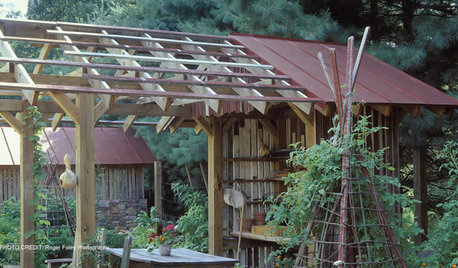Ideas for a LARGE trellis
nannerbelle
15 years ago
Related Stories

GARDENING AND LANDSCAPING12 One-of-a-Kind Trellis and Arbor Designs
Create Your Own Place for Vines, Flowers or a Romantic Chandelier
Full Story
BEDROOMS10 Ways to Create a Dressing Area Large or Small
Consider these ideas for carving out space in a corner of your bedroom, bathroom or closet
Full Story
DECORATING GUIDES13 Strategies for Making a Large Room Feel Comfortable
Bigger spaces come with their own layout and decorating challenges. These ideas can help
Full Story
LIVING ROOMSLay Out Your Living Room: Floor Plan Ideas for Rooms Small to Large
Take the guesswork — and backbreaking experimenting — out of furniture arranging with these living room layout concepts
Full Story
PRODUCT PICKSGuest Picks: Large Artwork for Your Space
Go big with 20 large-scale art finds for every room in the house
Full Story
WINDOWSTreatments for Large or Oddly Shaped Windows
Get the sun filtering and privacy you need even with those awkward windows, using panels, shutters, shades and more
Full Story
SMALL HOMESEasy Green: 10 Tiny Homes That Live Large
Go ahead, micromanage. These 10 inventive spaces show how to pack a lot of living and style into small square footage
Full Story
DECORATING GUIDESThe Faces Have It: Large Portraits Go Over Big
Oversize visages of celebrities and mere mortals make for double-take drama in interiors
Full Story
TRANSITIONAL STYLERoom of the Day: Dramatic Redesign Brings Intimacy to a Large Room
The daunting size of the living room once repelled this young family, but thanks to a new design, it’s now their favorite room in the house
Full Story






jay_7bsc
trianglejohn
Related Professionals
Carlisle Landscape Architects & Landscape Designers · Waunakee Landscape Architects & Landscape Designers · Mooresville Landscape Contractors · Williamsburg Landscape Contractors · Wilmington Landscape Contractors · Burien Landscape Contractors · Caldwell Landscape Contractors · Dallas Landscape Contractors · Hayward Landscape Contractors · Louisville Landscape Contractors · Palm Beach Gardens Landscape Contractors · Roswell Landscape Contractors · Southbury Landscape Contractors · York Landscape Contractors · 07920 Landscape Contractorsmbuckmaster
Iris GW
nannerbelleOriginal Author
trianglejohn
jay_7bsc
Iris GW
nckvilledudes
jay_7bsc
nckvilledudes
mbuckmaster
LadyGard
dottie_in_charlotte
whatsup